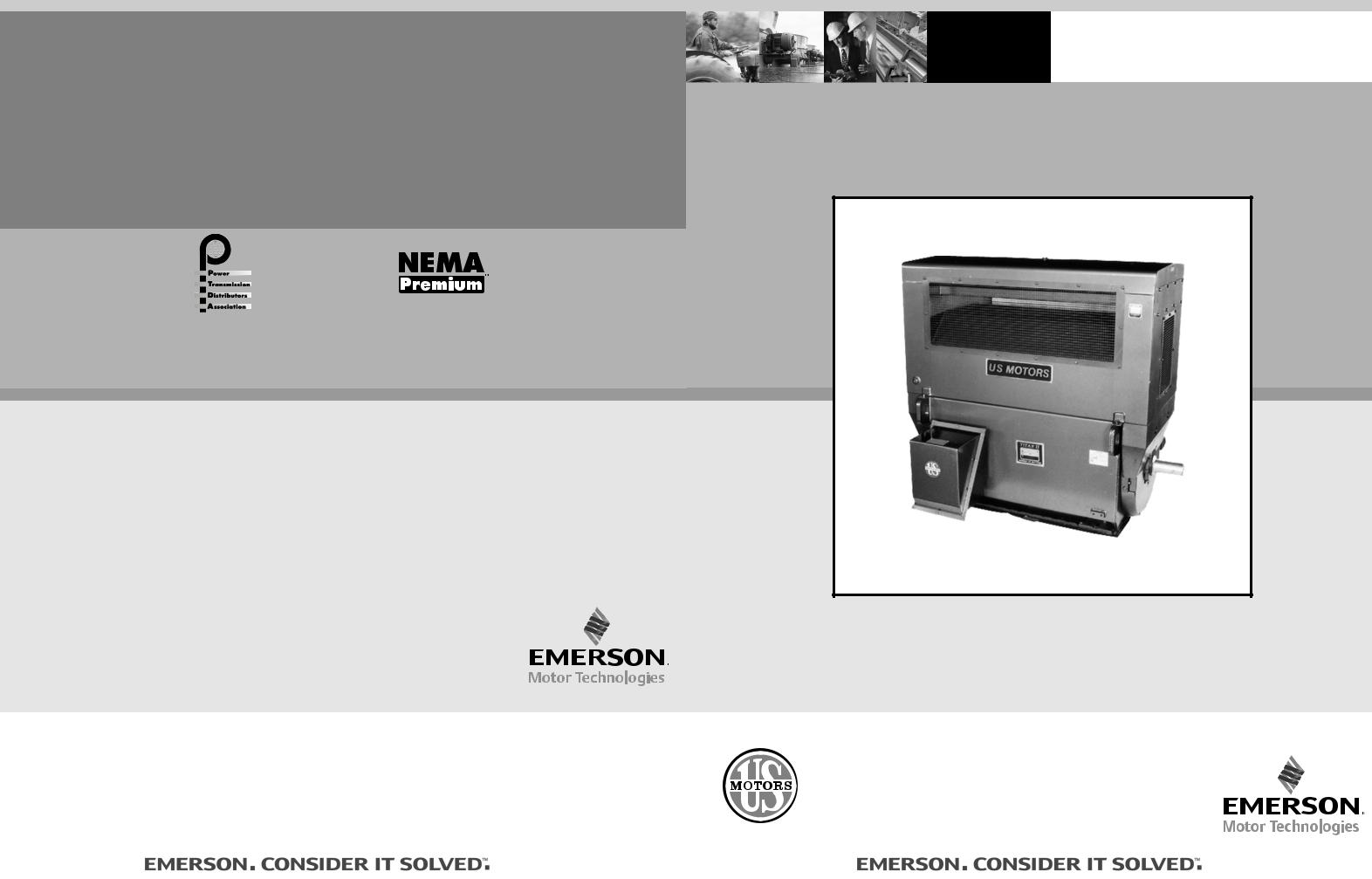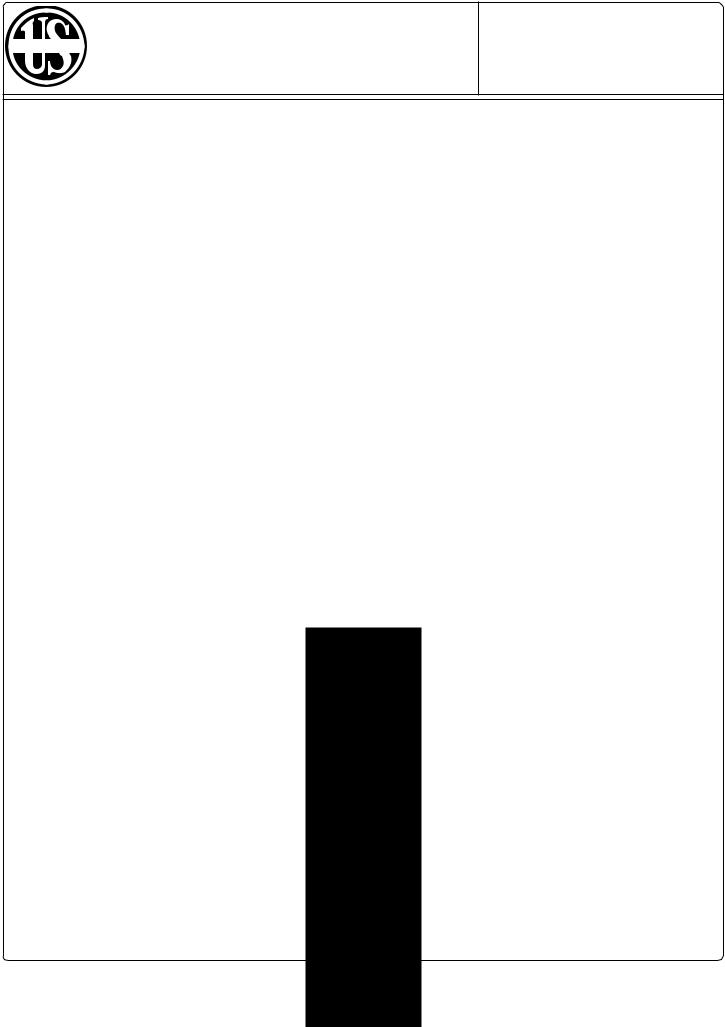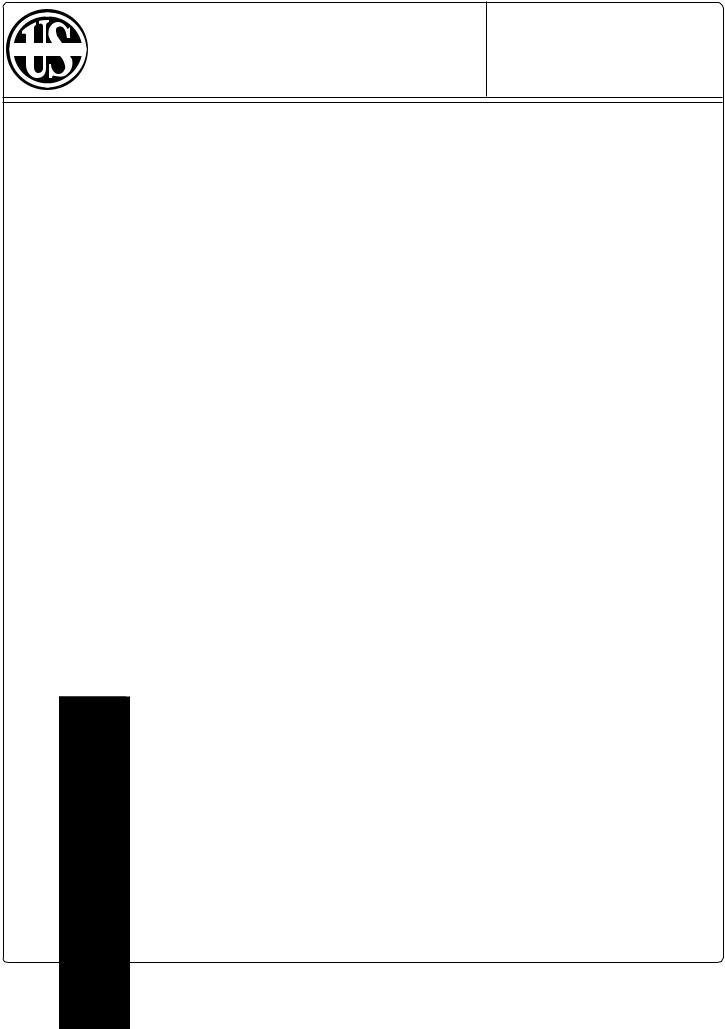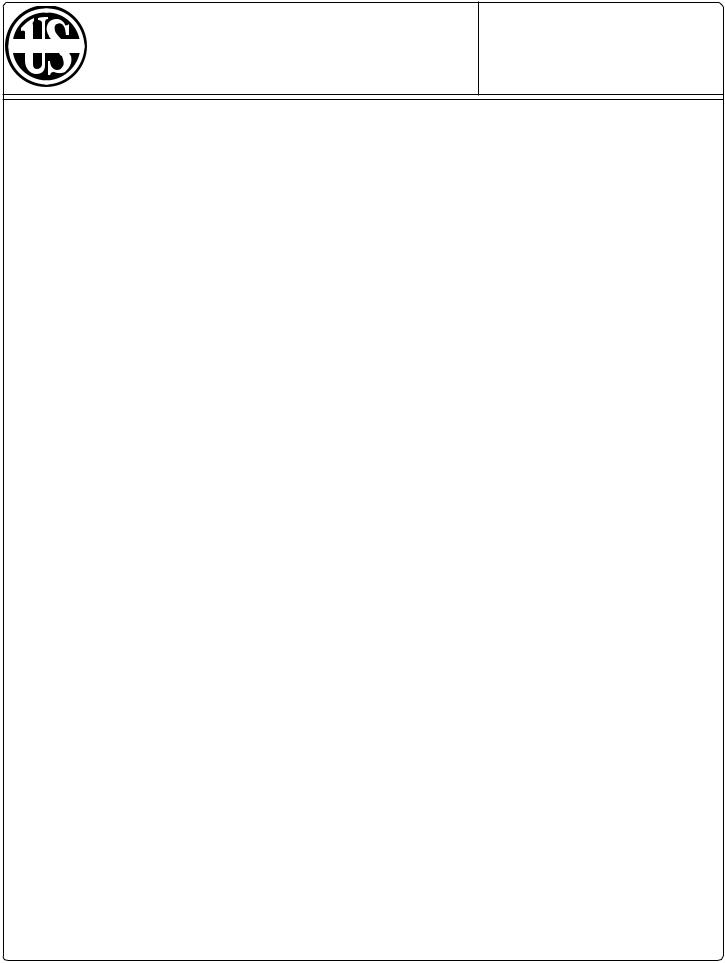Emerson 986269, LARGE AC ELECTRIC MOTORS User Manual

Emerson Motors
8100 West Florissant Ave. St. Louis, MO 63136 Phone: 888 637 7333 Fax: 314 553 2087
www.emersonmotors.com
All other marks are the properties of their respective owners.
The Emerson logo is a trademark and service mark of Emerson Electric Co.
TITAN II
LARGE AC ELECTRIC MOTORS
P/N 986269
HORIZONTAL MOTORS WITH ANTI-FRICTION BEARINGS
INSTALLATION, OPERATION AND MAINTENANCE MANUAL
IN234-204B |
Rev. 10/02 |
©Emerson Motor Company, 2002; All Rights Reserved |
©Emerson Motor Company, 2002; All Rights Reserved |

U.S. ELECTRICAL MOTORS 

 INSTALLATION AND MAINTENANCE
INSTALLATION AND MAINTENANCE
Safety
SAFETY FIRST
High voltage and rotating parts can cause serious injury or loss of life. Safe installation, operation and maintenance must be performed by qualified personnel. Familiarization with and adherence to NEMA MG2, the National Electrical Code, and local codes is recommended. It is important to observe safety precautions to protect personnel from possible injury. Personnel should be instructed to:
1.Disconnect all power to motor and accessories prior to initiating any maintenance or repairs.
2.Avoid contact with rotating parts.
3.Act with care in accordance with this manual's prescribed procedures in handling and installing this equipment.
4.Be sure unit and accessories are electrically grounded and proper electrical installation wiring and controls are used in accordance with local and national electrical codes. Refer to "National Electrical Code Handbook" - NFPA No. 70. Employ qualified electricians.
5.Be sure equipment is properly enclosed to prevent access by children or other unauthorized personnel in order to prevent possible accidents.
6.Be sure shaft key is fully captive before unit is energized.
7.Provide proper safeguards for personnel against rotating parts and applications involving high inertia loads which can cause overspeed.
8.Avoid extended exposure to equipment with high noise levels.
9.Observe good safety habits at all times and use care to avoid injury to yourself or damage to your equipment.
10.Be familiar with the equipment and read all instructions thoroughly before installing or working on equipment.
11.Observe all special instructions attached to the equipment. Remove shipping fixtures if so equipped.
12.Check motor and driven equipment for proper rotation and phase sequence prior to coupling. Also check if a unidirectional motor is supplied and note proper rotation.
13.Do not apply power factor correction capacitors to motors rated for operation
with variable frequently drives. Serious damage to the drive will result if capacitors are placed between the motor and drive. Consult your drive supplier for more information.

U.S. ELECTRICAL MOTORS |
Table of Contents |
INSTALLATION AND MAINTENANCE |
|
|
|
|
|
SECTION |
|
PAGE |
|
SAFETY ........................................................................................................................................................ |
|
i |
|
I. |
SHIPMENT ...................................................................................................................................... |
1 |
|
II. |
HANDLING ...................................................................................................................................... |
1 |
|
Ill. |
STORAGE ........................................................................................................................................ |
2 |
|
IV. |
INSTALLATION LOCATION ............................................................................................................. |
5 |
|
V. |
FOUNDATION .................................................................................................................................. |
5 |
|
VI. |
INITIAL INSTALLATION .................................................................................................................. |
6 |
|
|
1. |
Coupling or Pulley Installation. ............................................................................................. |
6 |
|
2. |
Rough Alignment ................................................................................................................... |
6 |
|
3. |
Final Alignment ..................................................................................................................... |
6 |
|
4. |
Electrical Connection ............................................................................................................ |
7 |
|
5. |
Reversing Rotation ................................................................................................................ |
8 |
|
6. |
Initial Start ............................................................................................................................ |
8 |
|
7. |
Vibration ................................................................................................................................ |
9 |
VII. |
NORMAL OPERATION .................................................................................................................... |
9 |
|
|
1. |
General Maintenance ........................................................................................................... |
9 |
|
2. |
Inspection and Cleaning ...................................................................................................... |
10 |
VIII. |
DOWELING ................................................................................................................................... |
10 |
|
IX. |
DISASSEMBLY ............................................................................................................................. |
11 |
|
X. |
REASSEMBLY ............................................................................................................................... |
11 |
|
XI. |
LUBRICATION ............................................................................................................................... |
12 |
|
XII. |
RENEWAL PARTS AND SERVICE .............................................................................................. |
14 |
|
XIII. |
CUTAWAYDRAWINGS .................................................................................................................. |
15 |
|
XIV. |
TROUBLESHOOTING .................................................................................................................... |
16 |
|
XV. |
INSTALLATION RECORD .............................................................................................................. |
18 |
|

U.S. ELECTRICAL MOTORS 

 INSTALLATION AND MAINTENANCE
INSTALLATION AND MAINTENANCE
Shipment &
Handling
I.SHIPMENT
Prior to shipment, all Titan-II Motors undergo extensive electrical and mechanical testing, and are thoroughly inspected. Upon receipt of the motor, carefully inspect the unit for any signs of damage that may have occurred during shipment. Should such damage be evident, unpack the motor at once in the presence of a claims adjuster and immediately report all damage and breakage to the transportation company and U.S Electrical Motors.
When contacting U.S Electrical Motors concerning the motor, be sure to include the complete motor identification number, frame and type which appears on the nameplate (see installation record in this manual).
II.HANDLING
The equipment needed to handle the motor includes a hoist and spreader bar arrangement of sufficient strength to lift the motor safely. The spreader bar arrangement should always be employed whenever multiple lifting lugs or eyebolts are provided (See Figures 1A & 1B). The spreader bar should have the lifting hooks positioned to equal the span of the eyebolts or lifting lugs. The eyebolts or lifting lugs provided are intended to lift the motor weight only. See Table 6 for motor weights.
 CAUTION
CAUTION
Lifting the motor by means other than specifically noted may result in damage to the motor or injury to personnel. Note that the eyebolt on the top of WPII enclosure is intended for lifting the tophat only.
FIGURE 1A |
FIGURE 1B |
Typical Construction With Two Eyebolts |
Typical Construction With Four Lifting Lugs |
|
|
1

U.S. ELECTRICAL MOTORS 

 INSTALLATION AND MAINTENANCE
INSTALLATION AND MAINTENANCE
Storage
III.STORAGE
1.When to put a Motor in Storage.
If a motor is not put into immediate service (one month or less), or if it is taken out of service for a prolonged period, special storage precautions should be taken to prevent damage. The following schedule is recommended as a guide to determine storage needs.
(A)Out of service or in storage less than one month - no special precautions except that space heaters, if supplied, must be energized at any time the motor is not running.
(B)Out of service or in storage for more than one but less than six months - store per Items 2 A through 2F, 2H, 3 and 4.
(C)Out of service or in storage for six months or more - all recommendations.
2.Storage Preparation.
(A)Where possible, motors should be stored indoors in a clean, dry area.
(B)When indoor storage is not possible, the motors must be covered with a tarpaulin. This cover should extend to the ground. Do not tightly wrap the motor as this will restrict air flow and result in surface condensation. Care must also be taken to protect the motor from flood damage or from any harmful chemical vapors.
(C)Whether indoors or out, the area of storage should be free from excessive vibration which can cause bearing damage.
(D)Precautions should be taken to prevent rodents, snakes, birds, or other small animals from nesting inside the motors. In areas where they are prevalent, precautions must also be taken to prevent insects, such as mud dauber wasps, from gaining access to the interior of the motor.
(E)Inspect the rust preventative coating on all external machined surfaces, including shaft extensions. If necessary, recoat the surfaces with a rust preventative material such as Rust Veto No. 342 (manufactured by E. F. Houghton Co.) or an equivalent. The condition of the coating should be checked periodically and surfaces recoated as needed.
(F)To prevent moisture accumulation, some form of heating must be utilized to prevent condensation. This heating should maintain the winding temperature at a minimum of 5°C above ambient. If space heaters are supplied, they should be energized. If none are available, single phase or "trickle" heating may be utilized by energizing one phase of the motor winding with a low voltage. Request the required voltage and transformer capacity from U.S. Electrical Motors. A third option is to use an auxiliary heat source to keep the winding warm by either convection or blowing warm air into the motor.
(G)Bearing cavities must be completely filled with lubricant during long term storage. Remove the drain plug and fill cavity with grease at the grease inlet until it begins to purge from the drain hole then replace the drain plug. Refer to Section XI "Lubrication" for recommended greases. At approximately 2 month intervals, a small quantity of grease should be injected into grease fitting with drain plug removed. Exiting grease should be inspected for moisture and contamination. If moisture or contamination is present, the motor bearings should be inspected and fresh grease installed.
2
